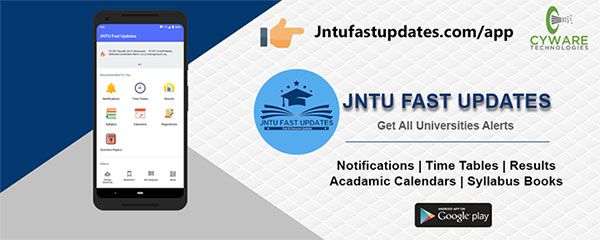JNTUK R20 2-2 Analog Communications Material/Notes PDF Download
Students those who are studying JNTUK R20 ECE Branch, Can Download Unit wise R20 2-2 Analog Communications Material/Notes PDFs below.

JNTUK R20 2-2 Analog Communications Material/Notes PDF Download
OBJECTIVES:
- Familiarize with the fundamentals of analog communicationsystems.
- Familiarize with various techniques for analog modulation and demodulation of signals.
- Distinguish the figure of merits of various analog modulationmethods.
- Develop the ability to classify and understand various functional blocks of radio transmitters andreceivers.
- Familiarize with basic techniques for generating and demodulating various pulse modulatedsignals.
UNIT-1
AMPLITUDE MODULATION : Introduction to communication system, Need for modulation, Frequency Division Multiplexing , Amplitude Modulation, Definition, Time domain and frequency domain description, single tone modulation, power relations in AM waves, Generation of AM waves, square law Modulator, Switching modulator, Detection of AM Waves; Square law detector, Envelope detector.
UNIT-2
DSB & SSB MODULATION: Double side band suppressed carrier modulators, time domain and frequency domain description, Generation of DSBSC Waves, Balanced Modulators, Ring Modulator, Coherent detection of DSB-SC Modulated waves, COSTAS Loop. Frequency domain description, Frequency discrimination method for generation of AM SSB Modulated Wave, Time domain description, Phase discrimination method for generating AM SSB Modulated waves. Demodulation of SSB Waves, Vestigial side band modulation: Frequency description, Generation of VSB Modulated wave, Time domain description, Envelope detection of a VSB Wave pulse Carrier, Comparison of AM Techniques, Applications of different AM Systems, FDM.
UNIT-3
ANGLE MODULATION: Basic concepts, Frequency Modulation: Single tone frequency modulation, Spectrum Analysis of Sinusoidal FM Wave, Narrow band FM, Wide band FM, Constant Average Power, Transmission bandwidth of FM Wave – Generation of FM Waves, Detection of FM Waves: Balanced Frequency discriminator, Zero crossing detector, Phase locked loop. Comparison of FM & AM.
UNIT-4
TRANSMITTERS & RECEIVERS: Radio Transmitter – Classification of Transmitter, AM Transmitter, Effect of feedback on performance of AM Transmitter, FM Transmitter – Variable reactance type and phase modulated FM Transmitter, frequency stability in FM Transmitter.
Radio Receiver – Receiver Types – Tuned radio frequency receiver, Super hetro dyne receiver, RF section and Characteristics – Frequency changing and tracking, Intermediate frequency, AGC, FM Receiver, Comparison with AM Receiver, Amplitude limiting. Communication Receivers, extensions of super heterodyne principle and additional circuits.
UNIT-5
NOISE: Review of noise and noise sources, noise figure, Noise in Analog communication Systems, Noise in DSB& SSB System, Noise in AM System, Noise in Angle Modulation Systems, Threshold effect in Angle Modulation System, Pre-emphasis & de-emphasis
PULSE MODULATION: Types of Pulse modulation, PAM (Single polarity, double polarity) PWM: Generation & demodulation of PWM, PPM, Generation and demodulation of PPM, Time Division Multiplexing, TDM Vs FDM
TEXT BOOKS:
- Principles of Communication Systems – H Taub & D. Schilling, Gautam Sahe,TMH, 3rd Edition,2007.
- Principles of Communication Systems – Simon Haykin, John Wiley, 2nd Edition,2007.
- Modern Digital and Analog Communication Systems –B.P.Lathi, Zhi Ding, Hari Mohan Gupta, Oxford University Press, 4th Edition, 2017
REFERENCE BOOKS:
- Electronics & Communication System – George Kennedy and Bernard Davis,TMH 2004.
- Communication Systems– R.P. Singh, SP Sapre, Second Edition TMH,2007.
- Electronic Communication systems – Tomasi, Pearson, fourth Edition,2007.
OUTCOMES:
- Differentiate various Analog modulation and demodulationschemes and their spectralcharacteristics
- Analyze noise characteristics of various analog modulationmethods
- Analyze various functional blocks of radio transmitters andreceivers
- Design simple analog systems for various modulationtechniques.

320-x100(1).gif)

Sir I request you to please keep the r23 materials for easy preparation to us.
May I request to pls put the r20 materials change with r19 materials some of the topics are not founded on it session of syllables students suffering for that
Thank you so much